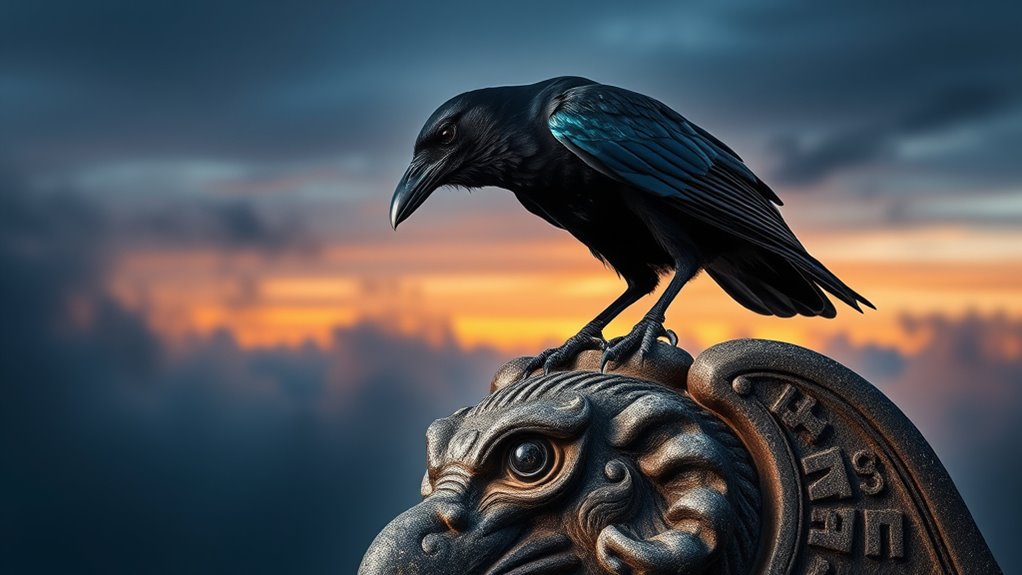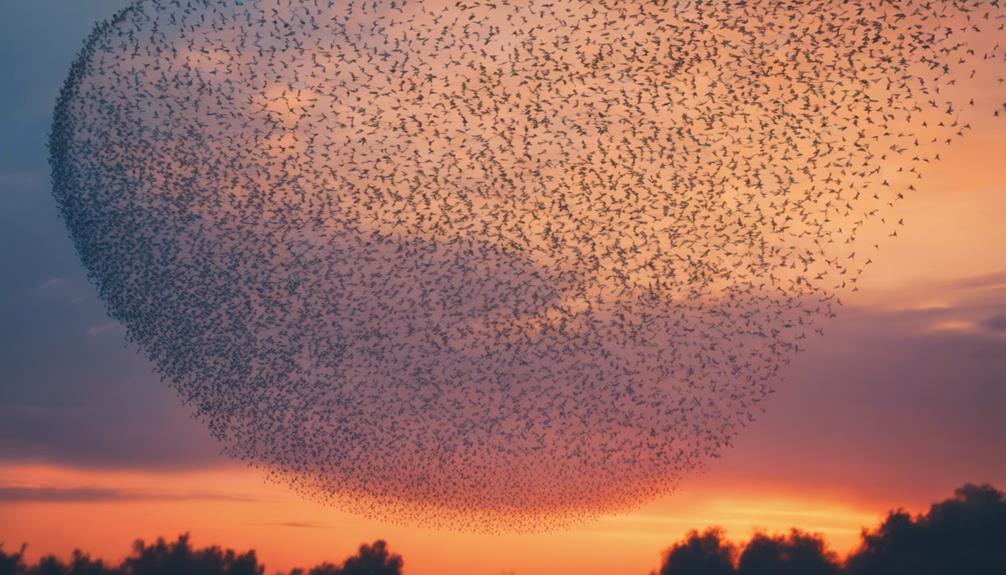Ravens are viewed worldwide as both omens and oracles because they symbolize mystery, intelligence, and divine insight. Cultures see them as messengers between worlds, revealing hidden truths and guiding critical moments. Their association with death, change, and spiritual wisdom makes them powerful symbols in many traditions, from Norse myth to Asian folklore. If you want to discover how these symbols influence different cultures and beliefs, there’s more to explore beyond this.
Key Takeaways
- Ravens symbolize divine messages and transformation, acting as intermediaries between the mortal world and higher realms across cultures.
- Their intelligence and mysterious behaviors foster beliefs that they can reveal hidden truths or future insights.
- Cultural interpretations link ravens to death, change, and divine guidance, positioning them as both omens and sources of wisdom.
- In various traditions, ravens are seen as lucky or protective symbols, enhancing their role as auspicious oracles.
- Their universal association with mystery and insight elevates them as powerful symbols of omens and divine oracles worldwide.

Throughout history, ravens have been regarded as powerful symbols of omens and oracles, often seen as messengers between the mortal world and the divine. Their striking black feathers, piercing eyes, and mysterious behavior have sparked awe and speculation across cultures. The symbolic significance of ravens varies widely, but they are almost universally linked to mystery, intelligence, and transformation. In many traditions, they are seen as guides or intermediaries that carry messages from beyond, acting as bridges between worlds. This perception is rooted in their uncanny ability to appear at critical moments, fueling the belief that they hold secret knowledge or foretell future events.
Cultural interpretations of ravens differ from one society to another, yet they all acknowledge their powerful symbolism. In Norse mythology, for example, Odin’s ravens, Huginn and Muninn, represent thought and memory, emphasizing the bird’s connection to wisdom and insight. Their presence signifies that knowledge is at hand, and they serve as oracles that deliver divine messages. Conversely, in some Indigenous North American traditions, ravens are seen as creators and tricksters, embodying both cleverness and chaos. They are revered as sacred beings capable of shaping reality and revealing hidden truths, often viewed as the ultimate symbols of transformation.
Across various cultures, ravens are also associated with death and the afterlife, further reinforcing their role as messengers of the divine. In Celtic and Christian symbolism, they sometimes serve as omens of change or forewarning of impending tragedy. Their ominous presence is believed to signal significant shifts, prompting you to pay close attention to your surroundings and trust your intuition. Meanwhile, in Japanese and Chinese traditions, ravens are considered auspicious, representing good luck, protection, and divine guidance. These contrasting interpretations highlight how cultural beliefs shape the symbolic significance of the bird, coloring perceptions of its role as an oracle.
You may notice that regardless of cultural differences, ravens inspire a sense of mystery and reverence. They are seen as intelligent, enigmatic creatures capable of conveying messages that transcend language and logic. Their symbolism urges you to look beyond the surface, to seek hidden meanings and trust your instincts when faced with uncertainty. Whether viewed as messengers, creators, or warnings, ravens continue to hold a special place in human imagination, embodying the unknown and serving as powerful symbols of transformation and divine insight across cultures worldwide. Additionally, their adaptability and intelligence make them particularly adept at navigating complex environments and delivering messages that resonate on multiple levels.
Frequently Asked Questions
Are Ravens Considered Sacred in Any Modern Religions?
You might wonder if ravens hold sacred status in modern religions. In some spiritual beliefs, raven symbolism is still significant, representing mystery, transformation, and wisdom. For example, in Native American traditions, ravens are considered sacred birds with deep spiritual significance. Similarly, some modern pagan and Wiccan practices revere ravens as symbols of magic and guidance. Their sacred bird significance continues to influence contemporary spiritual and religious thought today.
How Do Ravens Communicate Their Omens to Humans?
You notice that ravens communicate their omens through bird vocalizations and visual signaling. When a raven caws or makes distinct sounds, it’s often interpreted as a message or warning. Their visual cues, like a sudden flight pattern or specific postures, also serve as signals to humans. These behaviors have historically been seen as messages from the bird, conveying omens or insights about upcoming events.
Do All Cultures View Ravens as Both Omens and Oracles?
Did you know that over 100 cultures worldwide have mythological significance for ravens? When you ask if all cultures see ravens as both omens and oracles, the answer is no. Cultural perceptions vary greatly; some view them as messengers or guides, while others see them as symbols of death or transformation. The mythological significance of ravens influences how different societies interpret their behaviors, making their symbolism rich and diverse across the globe.
Can Ravens Actually Predict Future Events Accurately?
You might wonder if ravens can truly predict future events. While their remarkable bird intelligence suggests they are highly perceptive, there’s no scientific proof they foresee the future. Their mythological symbolism often associates them with omens or divine messages, but these stories are more about cultural interpretation than actual prediction. So, while they’re fascinating creatures, you shouldn’t rely on ravens to forecast what’s coming next.
What Symbolism Do Ravens Hold in Different Mythologies?
You’re curious about raven symbolism across mythologies, where these birds embody both mystery and insight. In Norse myth, ravens are seen as messengers of Odin, symbolizing wisdom and prophecy. Conversely, in Native American traditions, they often represent transformation and guidance. Their mythological significance varies—sometimes ominous, sometimes enlightening—highlighting their complex role as symbols of both foretelling and profound understanding in cultures worldwide.
Conclusion
Just as a raven perches silently on a branch, you stand at the crossroads of mystery and knowledge. Its black feathers whisper secrets from the shadows, guiding or warning you with silent messages. Embrace the raven’s dual nature—an omen and oracle—like a guardian of hidden truths. When you listen closely, you realize it’s not just a bird, but a bridge between the known and the unknown, guiding you through life’s darkest and brightest moments.











